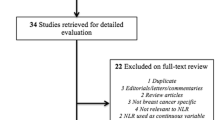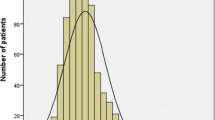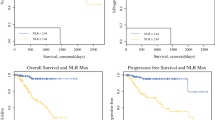Abstract
Background
The neutrophil-to-lymphocyte ratio (NLR) is a strong predictor of mortality in patients with cancer. Similarly, a study in a large series has shown that the newly defined derived NLR (dNLR; neutrophil/leukocyte–lymphocyte ratio) also has prognostic value. The present study retrospectively evaluates the prognostic significance of NLR and dNLR in breast cancer.
Methods
Hematological parameters and clinicopathological data during diagnosis were retrospectively recorded for 1,527 patients diagnosed with breast cancer at Izmir Katip Celebi University Ataturk Research and Training Hospital from January 2006 to December 2011. The cut-off values were determined by calculating the NLR and dNLR of the patients.
Results
The cut-off values were determined as 4 and 2 for NLR and dNLR, respectively. The association between NLR and dNLR assessed by Spearman’s rank correlation analysis was 0.935 (P < 0.001). There was a significant difference regarding disease free survival (DFS) and overall survival (OS) in patients with NLR <4 and NLR ≥4 (respectively, P < 0.00, P < 0.001). Similarly, there was a significant difference regarding DFS and OS in patients with dNLR <2 and dNLR ≥2 (respectively, P < 0.001, P < 0.001). Furthermore, NLR and dNLR demonstrated a significant association with the American Joint Committee on Cancer (AJCC) staging (P < 0.001). Assessment using the Cox proportional multivariate model showed that high NLR, pN, pT, luminal A-like, luminal B-like (HER2 positive), basal-like, and AJCC staging are independent prognostic factors.
Discussion
NLR was shown to be better than dNLR in terms of predicting prognosis in patients with breast cancer. However, large prospective studies are required to further demonstrate the prognostic significance of these two values.






Similar content being viewed by others
References
Siegel R, Ward E, Brawley O et al (2011) Cancer statistics, 2011: the impact of eliminating socioeconomic and racial disparities on premature cancer deaths. CA Cancer J Clin 61(4):212–236
Page DL (1991) Prognosis and breast cancer. Recognition of lethal and favorable prognostic types. Am J Surg Pathol 15(4):334–349
Rosen PP, Groshen S, Kinne DW et al (1993) Factors influencing prognosis in node-negative breast carcinoma: analysis of 767 T1N0M0/T2N0M0 patients with long-term follow-up. J Clin Oncol 11(11):2090–2100
Simpson JF, Page DL (1995) Status of breast cancer prognostication based on histopathologic data. Am J Clin Pathol 103(1):115
Fitzgibbons PL, Page DL, Weaver D et al (2000) Prognostic factors in breast cancer. College of American Pathologists Consensus Statement 1999. Arch Pathol Lab Med 124(7):966–978
Rakha EA, El-Sayed ME, Lee AH et al (2008) Prognostic significance of Nottingham histologic grade in invasive breast carcinoma. J Clin Oncol 26(19):3153–3158
Fisher B, Redmond C, Fisher ER et al (1988) Relative worth of estrogen or progesterone receptor and pathologic characteristics of differentiation as indicators of prognosis in node negative breast cancer patients: findings from National Surgical Adjuvant Breast and Bowel Project Protocol B-06. J Clin Oncol 6(7):1076–1087
Tandon AK, Clark GM, Chamness GC et al (1989) HER-2/neu oncogene protein and prognosis in breast cancer. J Clin Oncol 7(8):1120–1128
Andrulis IL, Bull SB, Blackstein ME et al (1998) Neu/erbB-2 amplification identifies a poor-prognosis group of women with node-negative breast cancer. Toronto Breast Cancer Study Group. J Clin Oncol 16(4):1340–1349
Ferrero-Poüs M, Hacène K, Bouchet C et al (2000) Relationship between c-erbB-2 and other tumor characteristics in breast cancer prognosis. Clin Cancer Res 6(12):4745–4754
Grann VR, Troxel AB, Zojwalla NJ et al (2005) Hormone receptor status and survival in a population-based cohort of patients with breast carcinoma. Cancer 103(11):2241–2251
Mantovani A, Allavena P, Sica A et al (2008) Cancer related inflammation. Nature 454(7203):436–444
Hilmy M, Bartlett JMS, Underwood MA et al (2005) The relationship between the systemic inflammatory response and survival in patients with transitional cell carcinoma of the urinary bladder. Br J Cancer 92(4):625–627
Crumley AB, McMillan DC, McKernan M et al (2006) An elevated C-reactive protein concentration, prior to surgery, predicts poor cancer-specific survival in patients undergoing resection for gastro-oesophageal cancer. Br J Cancer 94(11):1568–1571
Forrest LM, McMillan DC, McArdle CS et al (2003) Evaluation of cumulative prognostic scores based on the systemic inflammatory response in patients with inoperable non-small-cell lung cancer. Br J Cancer 89(6):1028–1030
Proctor MJ, Talwar D, Balmar SM et al (2010) The relationship between the presence and site of cancer, an inflammation-based prognostic score and biochemical parameters. Initial results of the Glasgow Inflammation Outcome Study. Br J Cancer 103:870–876
Schmidt H, Bastholt L, Geertsen P et al (2005) Elevated neutrophil and monocyte counts in peripheral blood are associated with poor survival in patients with metastatic melanoma: a prognostic model. Br J Cancer 93(3):273–278
Cho H, Kim JH (2009) Multiplication of neutrophil and monocyte counts (MNM) as an easily obtainable tumour marker for cervical cancer. Biomarkers 14(3):161–170
Sadik CD, Kim ND, Luster AD (2011) Neutrophils cascading their way to inflammation. Trends Immunol 32(10):452–460
Miskolci V, Rollins J, Vu HY et al (2007) NFkappaB is persistently activated in continuously stimulated human neutrophils. Mol Med 13(3–4):134–142
Calkins CM, Bensard DD, Shames BD et al (2002) IL-1 regulates in vivo C-X-C chemokine induction and neutrophil sequestration following endotoxemia. J Endotoxin Res 8(1):59–67
Leitch EF, Chakrabarti M, Crozier JE et al (2007) Comparison of the prognostic value of selected markers of the systemic inflammatory response in patients with colorectal cancer. Br J Cancer 97(9):1266–1270
Millrud CR, Månsson Kvarnhammar A, Uddman R et al (2012) The activation pattern of blood leukocytes in head and neck squamous cell carcinoma is correlated to survival. PLoS One 7(12):e51120
Ma JP, Wang Z, Lin JW et al (2011) Neutrophil-lymphocyte ratio as a prognostic factor in gastric cancer. Zhonghua Wei Chang Wai Ke Za Zhi 14(12):944–947
Wang S, Zhang Z, Fang F et al (2011) The neutrophil/lymphocyte ratio is an independent prognostic indicator in patients with bone metastasis. Oncol Lett 2(4):735–740
Ishizuka M, Nagata H, Takagi K et al (2012) Clinical significance of tumor pathology for postoperative survival of patients undergoing surgery for stage IV colorectal cancer. Anticancer Res 32(8):3291–3297
Proctor MJ, McMillan DC, Morrison DS et al (2012) A derived neutrophil to lymphocyte ratio predicts survival in patients with cancer. Br J Cancer 107(4):695–699
Wolff AC, Hammond ME, Schwartz JN et al (2007) American Society of Clinical Oncology/College of American Pathologists guideline recommendations for human epidermal growth factor receptor 2 testing in breast cancer. J Clin Oncol 25(1):118–145
Goldhirsch A, Winer EP, Coates AS et al (2013) Panel members. Personalizing the treatment of women with early breast cancer: highlights of the St Gallen International Expert Consensus on the Primary Therapy of Early Breast Cancer 2013. Ann Oncol 24(9):2206–2223
Goldhirsch A, Ingle JN, Gelber RD et al (2009) Thresholds for therapies: highlights of the St Gallen International Expert Consensus on the primary therapy of early breast cancer 2009. Ann Oncol 20(8):1319–1329
Azab B, Bhatt VR, Phookan J et al (2012) Usefulness of the neutrophil-to-lymphocyte ratio in predicting short- and long-term mortality in breast cancer patients. Ann Surg Oncol 19(1):217–224
Chua W, Charles KA, Baracos VE et al (2011) Neutrophil/lymphocyte ratio predicts chemotherapy outcomes in patients with advanced colorectal cancer. Br J Cancer 104(8):1288–1295
Keizman D, Ish-Shalom M, Huang P et al (2012) The association of pre-treatment neutrophil to lymphocyte ratio with response rate, progression free survival and overall survival of patients treated with sunitinib for metastatic renal cell carcinoma. Eur J Cancer 48(2):202–208
Conflict of interest
The authors declare that they have no conflict of interest.
Author information
Authors and Affiliations
Corresponding author
About this article
Cite this article
Dirican, A., Kucukzeybek, B.B., Alacacioglu, A. et al. Do the derived neutrophil to lymphocyte ratio and the neutrophil to lymphocyte ratio predict prognosis in breast cancer?. Int J Clin Oncol 20, 70–81 (2015). https://doi.org/10.1007/s10147-014-0672-8
Received:
Accepted:
Published:
Issue Date:
DOI: https://doi.org/10.1007/s10147-014-0672-8




